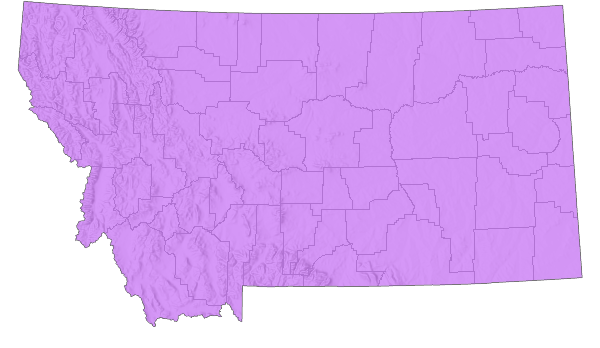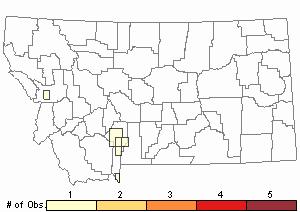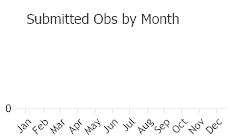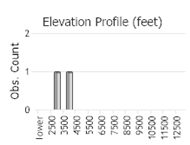View in other NatureServe Network Field Guides
NatureServe
Montana
Utah
Wyoming
Idaho
Wisconsin
British Columbia
South Carolina
Yukon
California
New York
Thomas' Broad-winged Grasshopper - Chloealtis abdominalis
Other Names:
Rocky Mountain Sprinkled Locust
General Description
The following comes from Brooks (1958), Helfer (1971), Otte (1981), Vickery and Kevan (1985), Capinera et al. (2004), and Scott (2010). This species exhibits sexual dimorphism between males and females. Males tend to be a grayish-brown dorsally, becoming a pale brown on the abdomen sides. The wings (tegmina) are bluntly rounded and do not reach the tip of the abdomen. Bottom of the hind femur bears a red stripe. Females tend to be gray in color, with shorter, more pointed wings.
Phenology
Overwinters in the egg stage. Adults occur from July through September (Capinera et al. 2004, Otte 1984, Scott 2010, and Vickery and Kevan 1985).
Diagnostic Characteristics
The following is taken from Brooks (1958), Helfer (1971), Otte (1981), Vickery and Kevan (1985), Capinera et al. (2004), and Scott (2010). Male body length is 18 to 19 mm, and females 23 to 28 mm. The lateral lobes of the pronotum are dark to black dorsally and becoming lighter from top to bottom, but never entirely black. The hind tibia is reddish-brown, merging to black at the tip.
The genus name for this species is
Neopodismopsis in Brooks (1958) and Helfer (1971). It is a congener with the
Sprinkled Broad-winged Grasshopper (
Chloealtis conspersa), but differs by not having totally black lateral lobes of the pronotum. Hind femur is not banded.
Species Range
Montana Range
Range Descriptions

 Native
Native
Range Comments
This species ranges from Alaska and all the western Canadian Provinces south into Montana, the Dakotas, to Arizona, and New Mexico. Eastward from the Rocky Mountain front to Ontario and Michigan. In Montana, it is recorded for 7 counties (Capinera et al. 2004, Otte 1984, Scott 2010, and Vickery and Kevan 1985).
Observations in Montana Natural Heritage Program Database
Number of Observations: 9
(Click on the following maps and charts to see full sized version)
Map Help and Descriptions
Relative Density

Recency



 (Observations spanning multiple months or years are excluded from time charts)
(Observations spanning multiple months or years are excluded from time charts)
Habitat
Thomas’ Broad-winged Grasshopper is widely distributed in various forest types and parklands. In grasslands, it is confined to grassy depressions and valleys. It occurs up to 11,000 feet in the Rockies (Capinera et al. 2004, Helfer 1971, Otte 1984, and Vickery and Kevan 1985).
Food Habits
This is a grass and sedge feeding grasshopper, favoring species in the following genera: Bouteloua, Stipa, Agropyron, Koeleria, and Carex (Brooks 1958, and Vickery and Kevan 1985).
Reproductive Characteristics
Little is known and documented about the reproductive cycle of Thomas’ Broad-winged Grasshopper. Some field observations have found that the females oviposit eggs in cattle manure, hence one of its common names is the “Cow Grasshopper.” Courting males sing (stridulate) one to three songs at one place and then wander through the grass before singing again (Otte 1984, and Vickery and Kevan 1985).
Stewardship Responsibility
References
- Literature Cited AboveLegend:
 View Online Publication
View Online Publication Brooks, A.R. 1958. Acridoidea of Southern Alberta, Saskatchewan, and Manitoba (Orthoptera). The Canadian Entomologist (Supplement 9) 90:5-92.
Brooks, A.R. 1958. Acridoidea of Southern Alberta, Saskatchewan, and Manitoba (Orthoptera). The Canadian Entomologist (Supplement 9) 90:5-92. Capinera, J.L., R.D. Scott, and T.J. Walker. 2004. Field Guide to Grasshoppers, Katydids, and Crickets of the United States. Ithaca, NY. Cornell University Press.
Capinera, J.L., R.D. Scott, and T.J. Walker. 2004. Field Guide to Grasshoppers, Katydids, and Crickets of the United States. Ithaca, NY. Cornell University Press. Helfer, J.R. 1971. How to Know the Grasshoppers, Crickets, Cockroaches, and Their Allies. Revised edition (out of print), Mineola, NY: Dover Publications.
Helfer, J.R. 1971. How to Know the Grasshoppers, Crickets, Cockroaches, and Their Allies. Revised edition (out of print), Mineola, NY: Dover Publications. Otte, Daniel. 1981. The North American Grasshoppers. Volume 1. Acrididae (Gomphocerinae and Acridinae). Harvard University Press. 275 pp.
Otte, Daniel. 1981. The North American Grasshoppers. Volume 1. Acrididae (Gomphocerinae and Acridinae). Harvard University Press. 275 pp. Scott, R.D. 2010. Montana Grasshoppers, Katydids, and Crickets A Pictorial Field Guide to the Orthoptera. MagpieMTGraphics, Billings, MT.
Scott, R.D. 2010. Montana Grasshoppers, Katydids, and Crickets A Pictorial Field Guide to the Orthoptera. MagpieMTGraphics, Billings, MT. Vickery, V. R. and D. K. M. Kevan. 1985. The grasshopper, crickets, and related insects of Canada and adjacent regions. Biosystematics Research Institute, Ottawa, Ontario. Publication Number 1777. 918 pp.
Vickery, V. R. and D. K. M. Kevan. 1985. The grasshopper, crickets, and related insects of Canada and adjacent regions. Biosystematics Research Institute, Ottawa, Ontario. Publication Number 1777. 918 pp.
- Additional ReferencesLegend:
 View Online Publication
View Online Publication
Do you know of a citation we're missing? Anderson, N.L. 1962. Grasshopper-vegetation relationships on Montana grasslands. Ph.D Dissertation. Bozeman, Montana: Montana State University. 73 p.
Anderson, N.L. 1962. Grasshopper-vegetation relationships on Montana grasslands. Ph.D Dissertation. Bozeman, Montana: Montana State University. 73 p. Bland, R.G. 2003. The Orthoptera of Michigan—Biology, Keys, and Descriptions of Grasshoppers, Katydids, and Crickets. East Lansing, MI: Michigan State University Extension, Bulletin E-2815. 221 p.
Bland, R.G. 2003. The Orthoptera of Michigan—Biology, Keys, and Descriptions of Grasshoppers, Katydids, and Crickets. East Lansing, MI: Michigan State University Extension, Bulletin E-2815. 221 p. Hebard, M. 1928. The Orthoptera of Montana. Proceedings of the Academy of Natural Sciences of Philadelphia, Vol. 80:211-306.
Hebard, M. 1928. The Orthoptera of Montana. Proceedings of the Academy of Natural Sciences of Philadelphia, Vol. 80:211-306. Henry, J.E. 1969. Protozoan and viral pathogens of grasshoppers. Ph.D. Dissertation. Bozeman, MT: Montana State University. 153 p.
Henry, J.E. 1969. Protozoan and viral pathogens of grasshoppers. Ph.D. Dissertation. Bozeman, MT: Montana State University. 153 p. Kirk, K. and C.R. Bomar. 2005. Guide to the grasshoppers of Wisconsin. Madison, WI: Wisconsin Department of Natural Resources, Bureau of Integrated Science Services PUB-SS-1008. 154 p.
Kirk, K. and C.R. Bomar. 2005. Guide to the grasshoppers of Wisconsin. Madison, WI: Wisconsin Department of Natural Resources, Bureau of Integrated Science Services PUB-SS-1008. 154 p.
- Web Search Engines for Articles on "Thomas' Broad-winged Grasshopper"
- Additional Sources of Information Related to "Insects"





